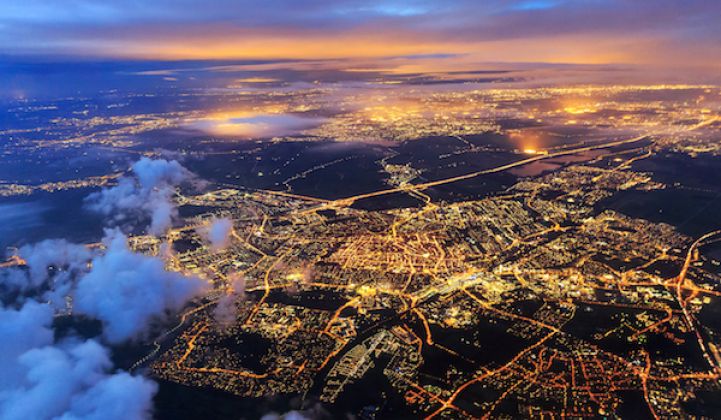The numbers draw a devastating portrait of California’s increasingly destructive wildfires. Last year nearly 8,000 wildfires burned over 250,000 acres of the state, according to the California Department of Forestry and Fire Protection. Though the state’s 2019 wildfires were severe, 2017 and 2018 were the deadliest and most destructive fire seasons in California’s history, resulting in over 100 deaths and razing thousands of homes.
The 2020 fire season will undoubtedly be challenging. Higher temperatures and a persistent drought driven by climate change have extended the duration of the state’s average fire season by 75 days. As of May, California’s snowpack was at just 37 percent of the average level, an indication of just how dry and combustible conditions are.
In 2019 the reality of persistent wildfire risk led California utilities to implement preventative blackouts as a way to eliminate the risk of grid equipment sparking fires. While these proactive measures reduced the threat of wildfires, they disrupted countless businesses and posed their own threats to health and safety.
For example, life-threatening complications can arise when critical facilities such as hospitals, fire stations and police stations experience prolonged power outages. A report by the Manhattan Institute estimates also that the October 9-12, 2019 PG&E shutoffs imposed costs totaling between $850 million and $1.7 billion on the 750,000 customers impacted in return for $500 million in benefits.
While proactive outages will continue to be used this fire season, PG&E also plans to deploy up to 450 megawatts of mobile diesel generators to deliver backup power. Taken together, though, it has been proven that these solutions aren’t sustainable over the long term and don’t fully leverage the dramatic advances that have been made in renewable energy, battery storage and digitalization.
“If you look at the solutions being deployed, which is to turn off power and send diesel to remote locations, that is very much a 1970 answer to a 2020 problem,” said Mark Feasel, president of smart grid for Schneider Electric North America. “We have the opportunity to embrace this digitized, decentralized and decarbonized approach. Unfortunately, very little progress has been made toward that in 2019 and 2020.”
Microgrids: A modern solution
Improved economics and technology have made microgrids a viable solution to deliver digitized, decarbonized and decentralized backup power. In fact, supply-chain disruptions resulting from the COVID-19 pandemic have only underscored the importance of microgrids’ ability to provide onsite renewable generation.
“One reason renewable energy is so important is because it doesn’t require fuel,” said Feasel. “We can point to many cases, like the hurricanes in Puerto Rico, where fuel supply lines were disrupted. People were without power because they couldn’t get access to diesel, which is why diversity of fuel supply is a key tenet of resilience.”
Microgrids can also be built quickly and customized to the needs of businesses and municipalities. For example, Feasel says step one in designing a microgrid is to understand the nature of the load. “Some of the loads are nice-to-haves, like a soda machine, but nobody would notice if they were off for a week or two. Others, such as general service water pumps, can be cycled on and off and operate at times when solar generation is highest,” he said. “Then you have loads that can’t take an outage at all like an MRI machine. The knowledge of the load is a key driver in how we design the right solution.”
Customers still need to prioritize cost, resilience and sustainability. For manufacturers and food processors, eliminating production stoppages stemming from blackouts may be most important, though a nuanced mix of factors drives most decisions. For example, Montgomery County in Maryland opted for a microgrid in the wake of a 2012 storm that caused extended power outages. But cost and sustainability were also important criteria.
“Montgomery County believes it’s a place where businesses and people locate because they care about sustainability and reducing their carbon footprint,” said Feasel. “But it also prioritized resiliency and didn’t want to pay more for energy than it had been paying before.”
Removing microgrid barriers
Given their potential, why are microgrids not a ubiquitous solution for businesses and communities facing wildfire or other disaster-related blackouts? In the past, the ability to integrate microgrids with other fuel sources as well as public safety systems and utility price signals were barriers. Advances in digitalization have solved those problems.
But regulatory policy remains a significant hurdle. “Regulators can help by creating a dynamic where consumers can solve their own problem. Maybe it’s a business doing something on their own site, or maybe it’s the consumer working with an aggregator operating in a nonregulated format to deliver some of these solutions,” said Feasel.
More specifically, regulators can eliminate uncertainty about whether microgrids can be interconnected and commissioned quickly and operated without disruption in the future. Regulators can also help by clarifying rules around financial incentives. “It’s not only about where an incentive program exists — and there are several in California — but can I monetize them? For example, some are tax rebates that don’t apply to some public entities.”
Perhaps the biggest impediment to more widespread use of microgrids has already been solved by the maturation of the energy-as-a-service business model. This is when a business or municipality enters into a long-term, fixed-price contract with a microgrid developer that handles the technology selection and installation of a microgrid that meets their resilience, sustainability and cost metrics. Importantly, this approach doesn’t require upfront capital expense and delivers long-term cost certainty.
“There’s an entire array of technology questions that are extremely difficult to answer unless you live and breathe in this space every day,” said Feasel. “The greatest benefit of the energy-as-a-service business model is that it transfers all of these risks to someone else.”




